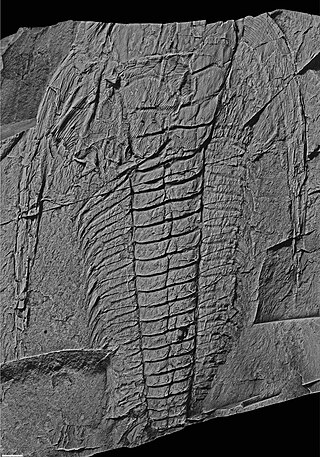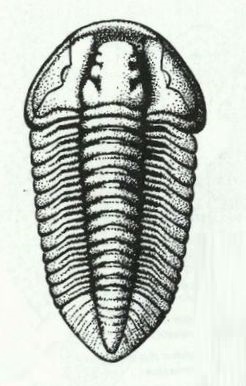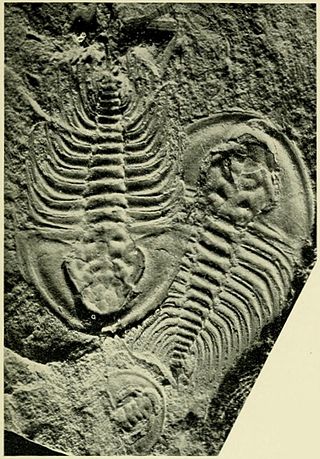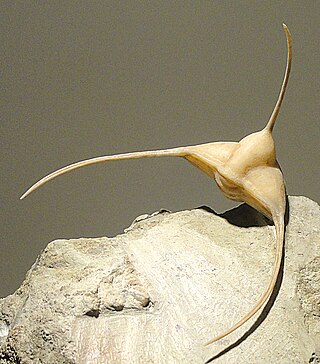
The Early Ordovician is the first epoch of the Ordovician period, corresponding to the Lower Ordovician series of the Ordovician system. It began after the Age 10 of the Furongian epoch of the Cambrian and lasted from 485.4 ± 1.9 to 470 ± 1.4 million years ago, until the Dapingian age of the Middle Ordovician. It includes Tremadocian and Floian ages.

John William Salter was an English naturalist, geologist, and palaeontologist.

The Tremadocian is the lowest stage of Ordovician. Together with the later Floian Stage it forms the Lower Ordovician Epoch. The Tremadocian lasted from 485.4 to 477.7 million years ago. The base of the Tremadocian is defined as the first appearance of the conodont species Iapetognathus fluctivagus at the Global Boundary Stratotype Section and Point (GSSP) section on Newfoundland.

The Furongian is the fourth and final epoch and series of the Cambrian. It lasted from 497 to 485.4 million years ago. It succeeds the Miaolingian series of the Cambrian and precedes the Lower Ordovician Tremadocian Stage. It is subdivided into three stages: the Paibian, Jiangshanian and the unnamed 10th stage of the Cambrian.

Flexicalymene Shirley, 1936. is a genus of trilobites belonging to the order Phacopida, suborder Calymenina and Family Calymenidae. Flexicalymene specimens can be mistaken for Calymene, Gravicalymene, Diacalymene and a few other Calymenina genera. They are used as an index fossil in the Ordovician. Ohio and North America are particularly known for being rich with Flexicalymene fossils.

The Fezouata Formation or Fezouata Shale is a geological formation in Morocco which dates to the Early Ordovician. It was deposited in a marine environment, and is known for its exceptionally preserved fossils, filling an important preservational window beyond the earlier and more common Cambrian Burgess shale-type deposits. The fauna of this geological unit is often described as the Fezouata biota, and the particular strata within the formation which exhibit exceptional preservation are generally termed the Fezouata Lagerstätte.

Fritzolenellus is an extinct genus from a well-known class of fossil marine arthropods, the trilobites, with three known species. It lived during the early part of the Botomian stage, which lasted from approximately 524 to 518.5 million years ago. This faunal stage was part of the Cambrian Period. Fritzolenellus occurred in parts of the paleocontinent Laurentia in what are now Northwestern Canada, Northwestern Scotland, and North-Greenland.
Stage 10 of the Cambrian is the still unnamed third and final stage of the Furongian series. It follows the Jiangshanian and precedes the Ordovician Tremadocian Stage. The proposed lower boundary is the first appearance of the trilobite Lotagnostus americanus around 489.5 million years ago, but other fossils are also being discussed. The upper boundary is defined as the appearance of the conodont Iapetognathus fluctivagus which marks the beginning of the Tremadocian and is radiometrically dated as 485.4 million years ago.

Trinodus is a very small to small blind trilobite, a well known group of extinct marine arthropods, which lived during the Ordovician, in what are now the Yukon Territories, Virginia, Italy, Czech Republic, Poland, Denmark, Sweden, Svalbard, Ireland, Scotland, Wales, Iran, Kazakhstan and China. It is one of the last of the Agnostida order to survive.

Cyclopyge is a genus of small to average size trilobites that lived during the Ordovician. Like all members of the family Cyclopigidae, it has very large convex eyes, that cover most of the free cheeks, and in some species touch each other. The eyes almost touch the large glabella. The occipital ring has merged with the rest of the glabella. The glabella does not extend into a frontal thorn. The cephalon lacks genal spines. The 6 thorax segments have short pleurae. The pygidium is rather large, and often rather effaced. These are features that also occur in other Cyclopygidae, and are indications of a pelagic lifestyle.

Cyclopygidae is a family of asaphid trilobites from the Ordovician. Cyclopygids had an extratropical distribution, and there is evidence that they lived in darker parts of the water column. Cyclopygids are characterized by enlarged eyes, with a wide angle of view, both horizontal and vertical, reminiscent of the eyes of dragonflies. These typically touch the glabella directly on the side. Cyclopygids all lack genal spines, but Symphysops carries a forward directed frontal spine on the glabella. It is presumed that at least the members of the genus Pricyclopyge swam upside down and had bioluminescent organs on the third thorax segment. Cyclopygids had between 7 and 5 thorax segments, a wide and stout axis, and short side lobes.
Sagavia is a genus of trilobites that lived during the Middle and Upper Ordovician in what are now Northwest and Southeast China, North Kazakhstan and Wales. It is a typical cyclopygid that can be distinguished by its large but separate eyes, elongated glabella, five thorax segments and a pygidium with clearly defined axis and border.

Raphiophoridae is a family of small to average-sized trilobites that first occurred at the start of the Ordovician and became extinct at the end of the Middle Silurian.

Telephinidae is a family of pelagic trilobites with large wide-angle eyes, occupying most of the free cheeks, downward directed facial spines and 9-10 thorax segments. The family is known during the entire Ordovician and occurred in deep water around the globe.
Kallidontus is an extinct genus of conodonts.

Histiodella is an extinct genus of conodonts.
The Letná Formation is a Late Ordovician geologic formation of the Prague Basin, Bohemian Massif in the Czech Republic. The formation crops out in the Czech capital, more specifically at Letná Hill, after which the formation is named. The type locality is located at Malá Strana, Holešovice district.
Calodiscus is a genus of Eodiscinid trilobite in the family Calodiscidae. It lived during the late Lower Cambrian, with remains found in Canada, the United States, Greenland, The United Kingdom (England), Sweden, France, Germany, Italy (Sardinia), Kazakhstan, the Russian Federation and China.

The Saint-Chinian Formation is a geological formation composed of shales with limestone inclusions, dating from the Lower Ordovician (Tremadocian).
Dudleyaspis is an extinct genus of Lower to Middle Devonian odontopleurid trilobites that lived in a shallow sea that lay between Euramerica and Gondwana. It was named in 1949 by Prantl & Pribyl.













